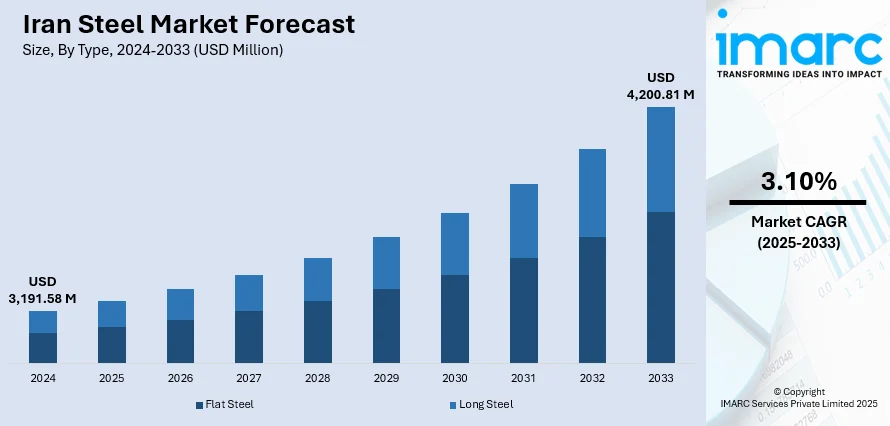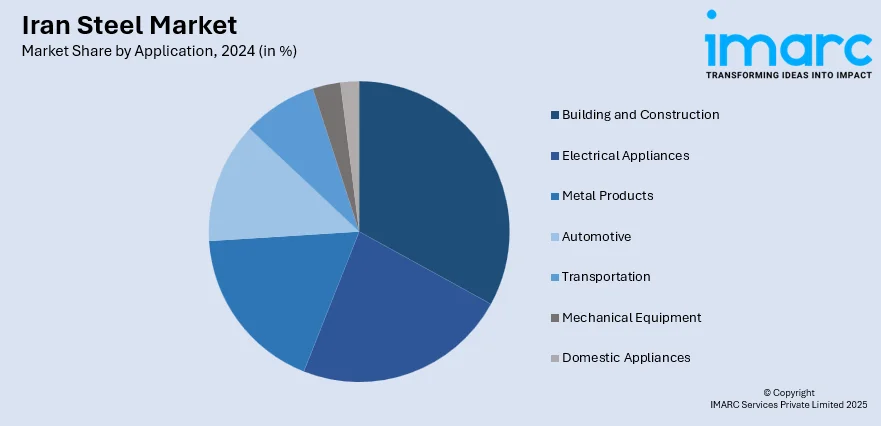
Iran Steel Market Size, Share, Trends and Forecast by Type, Product, Application, and Province, 2025-2033
Iran Steel Market Overview:
The Iran steel market size reached USD 3,191.58 Million in 2024. Looking forward, the market is expected to reach USD 4,200.81 Million by 2033, exhibiting a growth rate (CAGR) of 3.10% during 2025-2033. The market is driven by rising infrastructure development, government investment in industrialization, and robust domestic demand from the construction and automotive sectors. Export opportunities to neighboring countries and increased capacity from new production facilities further support Iran steel market share.
|
Report Attribute
|
Key Statistics
|
|---|---|
|
Base Year
|
2024 |
|
Forecast Years
|
2025-2033
|
|
Historical Years
|
2019-2024
|
| Market Size in 2024 | USD 3,191.58 Million |
| Market Forecast in 2033 | USD 4,200.81 Million |
| Market Growth Rate 2025-2033 | 3.10% |
Iran Steel Market Trends:
Infrastructure and Construction Expansion
Iran’s strategic investment in infrastructure remains a major catalyst for steel demand. Government-led projects in roads, bridges, railways, and housing significantly increase the consumption of structural steel. . For instance, Iran's steel industry, led by Mobarakeh, Esfahan, and Khouzestan Steel, accounts for 70% of national output. In 2024, Iran produced 3.3 million tons of crude steel, briefly ranking Iran 7th globally. The sector is vital for construction, autos, and energy, with output projected to reach 55 million tons by 2025. Iran seeks $20B investment, benefiting from abundant resources but limited by sanctions in high-alloy steel technology. Urban development programs, particularly mass housing and earthquake reconstruction, require large volumes of rebar, beams, and sheets. The construction of industrial parks, refineries, and energy facilities also fuels demand for high-grade steel products. With abundant natural resources such as iron ore and natural gas, Iran benefits from cost-effective raw material sourcing. A growing population and rapid urbanization further accelerate construction activities nationwide. These infrastructure-driven requirements consistently support domestic steel consumption, reduce reliance on imports, and stimulate industrial growth. This strong internal demand base continues to drive Iran steel market growth and strengthens its contribution to overall Iran steel market share.

To get more information on this market, Request Sample
Export Orientation and Regional Demand
Iran's surplus steel production has positioned the country as a key exporter within the Middle East and Central Asia. With domestic consumption lower than total output, producers target external markets to sustain operational efficiency. Neighboring nations like Iraq, Afghanistan, and Syria rely heavily on Iranian steel for construction and industrial use. Iran’s geographical location, competitive pricing, and access to raw materials make it a preferred supplier in the region. Despite international sanctions, alternative trade arrangements such as border trade and barter systems allow continued exports. Investments in transportation infrastructure, including rail and port upgrades, enhance export logistics. Policy measures like export incentives and tax relief support this outward-focused strategy. As demand from post-conflict and developing countries grows, Iran’s export capacity ensures revenue continuity and supports Iran steel market growth while expanding Iran steel market share regionally. For instance, at the 7th Iran Expo in May 2025, Mobarakeh Steel Group, the Middle East’s largest and global leader in Direct Reduced Iron, urged India, the world’s second-largest steel producer, for market access to export semi-finished steel slabs amid rapid infrastructure growth. With over 50% of Iran’s steel output, the company faces challenges due to US/EU sanctions disrupting SWIFT payments and maritime shipping. It emphasized that easing these barriers, even for a modest import share, would foster bilateral cooperation.
Iran Steel Market Segmentation:
IMARC Group provides an analysis of the key trends in each segment of the market, along with forecasts at the country and provincial levels for 2025-2033. Our report has categorized the market based on type, product, and application.
Type Insights:
- Flat Steel
- Long Steel
The report has provided a detailed breakup and analysis of the market based on the type. This includes flat steel and long steel.
Product Insights:
- Structural Steel
- Prestressing Steel
- Bright Steel
- Welding Wire and Rod
- Iron Steel Wire
- Ropes
- Braids
A detailed breakup and analysis of the market based on the product have also been provided in the report. This includes structural steel, prestressing steel, bright steel, welding wire and rod, iron steel wire, ropes, and braids.
Application Insights:

- Building and Construction
- Electrical Appliances
- Metal Products
- Automotive
- Transportation
- Mechanical Equipment
- Domestic Appliances
The report has provided a detailed breakup and analysis of the market based on the application. This includes building and construction, electrical appliances, metal products, automotive, transportation, mechanical equipment, and domestic appliances.
Province Insights:
- Tehran
- Khuzestan
- Bushehr
- Esfahan
- Khorasan
- Others
The report has also provided a comprehensive analysis of all the major provincial markets, which include Tehran, Khuzestan, Bushehr, Esfahan, Khorasan, and others.
Competitive Landscape:
The market research report has also provided a comprehensive analysis of the competitive landscape. Competitive analysis such as market structure, key player positioning, top winning strategies, competitive dashboard, and company evaluation quadrant has been covered in the report. Also, detailed profiles of all major companies have been provided.
Iran Steel Market Report Coverage:
| Report Features | Details |
|---|---|
| Base Year of the Analysis | 2024 |
| Historical Period | 2019-2024 |
| Forecast Period | 2025-2033 |
| Units | Million USD |
| Scope of the Report |
Exploration of Historical Trends and Market Outlook, Industry Catalysts and Challenges, Segment-Wise Historical and Future Market Assessment:
|
| Types Covered | Flat Steel, Long Steel |
| Products Covered | Structural Steel, Prestressing Steel, Bright Steel, Welding Wire and Rod, Iron Steel Wire, Ropes, Braids |
| Applications Covered | Building and Construction, Electrical Appliances, Metal Products, Automotive, Transportation, Mechanical Equipment, Domestic Appliances |
| Provinces Covered | Tehran, Khuzestan, Bushehr, Esfahan, Khorasan, Others |
| Customization Scope | 10% Free Customization |
| Post-Sale Analyst Support | 10-12 Weeks |
| Delivery Format | PDF and Excel through Email (We can also provide the editable version of the report in PPT/Word format on special request) |
Key Questions Answered in This Report:
- How has the Iran steel market performed so far and how will it perform in the coming years?
- What is the breakup of the Iran steel market on the basis of type?
- What is the breakup of the Iran steel market on the basis of product?
- What is the breakup of the Iran steel market on the basis of application?
- What is the breakup of the Iran steel market on the basis of province?
- What are the various stages in the value chain of the Iran steel market?
- What are the key driving factors and challenges in the Iran steel market?
- What is the structure of the Iran steel market and who are the key players?
- What is the degree of competition in the Iran steel market?
Key Benefits for Stakeholders:
- IMARC’s industry report offers a comprehensive quantitative analysis of various market segments, historical and current market trends, market forecasts, and dynamics of the Iran steel market from 2019-2033.
- The research report provides the latest information on the market drivers, challenges, and opportunities in the Iran steel market.
- Porter's five forces analysis assist stakeholders in assessing the impact of new entrants, competitive rivalry, supplier power, buyer power, and the threat of substitution. It helps stakeholders to analyze the level of competition within the Iran steel industry and its attractiveness.
- Competitive landscape allows stakeholders to understand their competitive environment and provides an insight into the current positions of key players in the market.
Need more help?
- Speak to our experienced analysts for insights on the current market scenarios.
- Include additional segments and countries to customize the report as per your requirement.
- Gain an unparalleled competitive advantage in your domain by understanding how to utilize the report and positively impacting your operations and revenue.
- For further assistance, please connect with our analysts.
 Request Customization
Request Customization
 Speak to an Analyst
Speak to an Analyst
 Request Brochure
Request Brochure
 Inquire Before Buying
Inquire Before Buying




.webp)




.webp)












